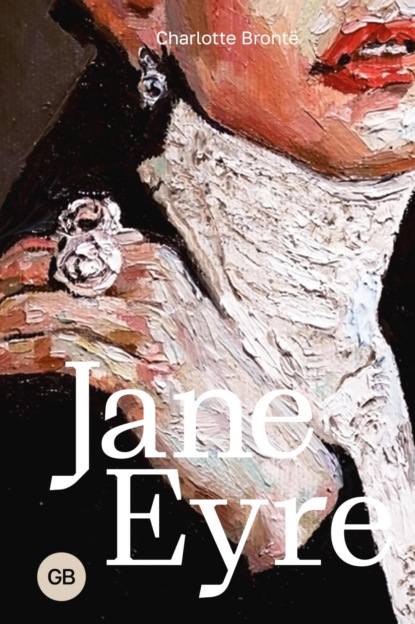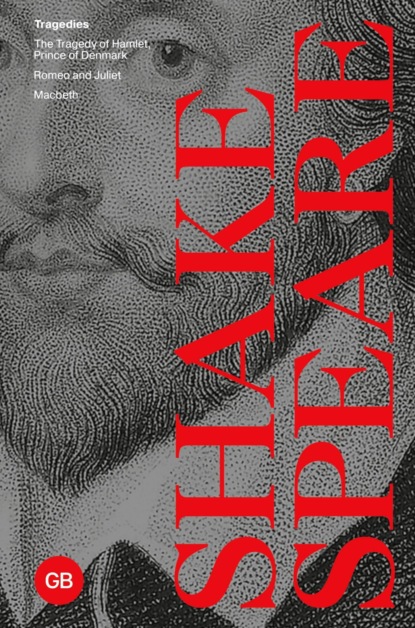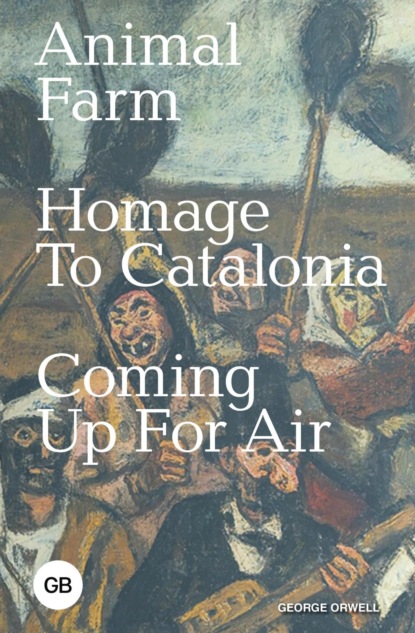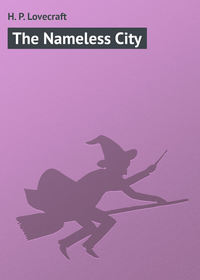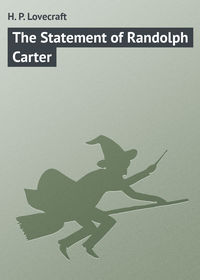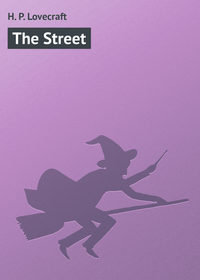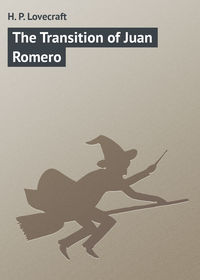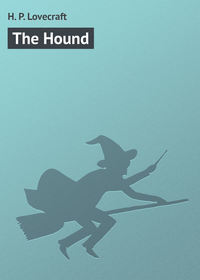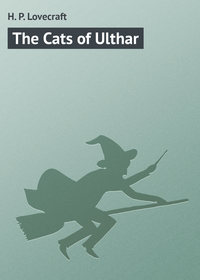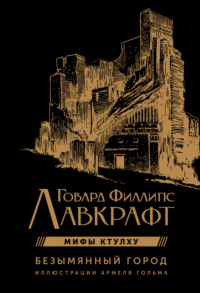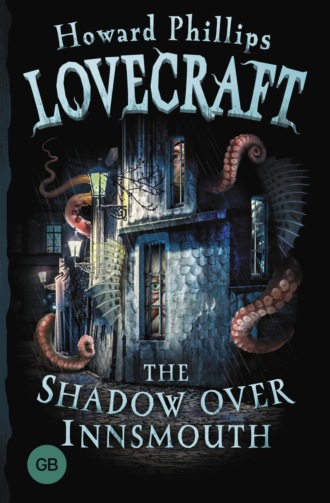
Полная версия
The Shadow over Innsmouth / Морок над Инсмутом
A certain greasiness about the fellow increased my dislike. He was evidently given to working or lounging around the fish docks, and carried with him much of their characteristic smell. Just what foreign blood was in him I could not even guess. His oddities certainly did not look Asiatic, Polynesian, Levantine, or negroid, yet I could see why the people found him alien. I myself would have thought of biological degeneration rather than alienage.
I was sorry when I saw that there would be no other passengers on the bus. Somehow I did not like the idea of riding alone with this driver. But as leaving time obviously approached I conquered my qualms and followed the man aboard, extending him a dollar bill and murmuring the single word “Innsmouth”. He looked curiously at me for a second as he returned forty cents change without speaking. I took a seat far behind him, but on the same side of the bus, since I wished to watch the shore during the journey.
At length the decrepit vehicle started with a jerk, and rattled noisily past the old brick buildings of State Street amidst a cloud of vapour from the exhaust. Glancing at the people on the sidewalks, I thought I detected in them a curious wish to avoid looking at the bus – or at least a wish to avoid seeming to look at it. Then we turned to the left into High Street, where the going was smoother; flying by stately old mansions of the early republic and still older colonial farmhouses, passing the Lower Green and Parker River, and finally emerging into a long, monotonous stretch of open shore country.
The day was warm and sunny, but the landscape of sand, sedge-grass, and stunted shrubbery became more and more desolate as we proceeded. Out the window I could see the blue water and the sandy line of Plum Island, and we presently drew very near the beach as our narrow road veered off from the main highway to Rowley and Ipswich. There were no visible houses, and I could tell by the state of the road that traffic was very light hereabouts. The small, weather-worn telephone poles carried only two wires. Now and then we crossed crude wooden bridges over tidal creeks that wound far inland and promoted the general isolation of the region.
Once in a while I noticed dead stumps and crumbling foundation-walls above the drifting sand, and recalled the old tradition quoted in one of the histories I had read, that this was once a fertile and thickly settled countryside. The change, it was said, came simultaneously with the Innsmouth epidemic of 1846, and was thought by simple folk to have a dark connexion with hidden forces of evil. Actually, it was caused by the unwise cutting of woodlands near the shore, which robbed the soil of its best protection and opened the way for waves of wind-blown sand.
At last we lost sight of Plum Island and saw the vast expanse of the open Atlantic on our left. Our narrow course began to climb steeply, and I felt a singular sense of disquiet in looking at the lonely crest ahead where the rutted roadway met the sky. It was as if the bus were about to keep on in its ascent, leaving the sane earth altogether and merging with the unknown arcana of upper air and cryptical sky. The smell of the sea took on ominous implications, and the silent driver’s bent, rigid back and narrow head became more and more hateful. As I looked at him I saw that the back of his head was almost as hairless as his face, having only a few straggling yellow strands upon a grey scabrous surface.
Then we reached the crest and beheld the outspread valley beyond, where the Manuxet joins the sea just north of the long line of cliffs that culminate in Kingsport Head and veer off toward Cape Ann. On the far, misty horizon I could just make out the dizzy profile of the Head, topped by the queer ancient house of which so many legends are told; but for the moment all my attention was captured by the nearer panorama just below me. I had, I realised, come face to face with rumour-shadowed Innsmouth.
It was a town of wide extent and dense construction, yet one with a portentous dearth of visible life. From the tangle of chimney-pots scarcely a wisp of smoke came, and the three tall steeples loomed stark and unpainted against the seaward horizon. One of them was crumbling down at the top, and in that and another there were only black gaping holes where clock-dials should have been. The vast huddle of sagging gambrel roofs and peaked gables conveyed with offensive clearness the idea of wormy decay, and as we approached along the now descending road I could see that many roofs had wholly caved in. There were some large square Georgian houses, too, with hipped roofs, cupolas, and railed “widow’s walks”. These were mostly well back from the water, and one or two seemed to be in moderately sound condition. Stretching inland from among them I saw the rusted, grass-grown line of the abandoned railway, with leaning telegraph-poles now devoid of wires, and the half-obscured lines of the old carriage roads to Rowley and Ipswich.
The decay was worst close to the waterfront, though in its very midst I could spy the white belfry of a fairly well-preserved brick structure which looked like a small factory. The harbour, long clogged with sand, was enclosed by an ancient stone breakwater; on which I could begin to discern the minute forms of a few seated fishermen, and at whose end were what looked like the foundations of a bygone lighthouse. A sandy tongue had formed inside this barrier, and upon it I saw a few decrepit cabins, moored dories, and scattered lobster-pots. The only deep water seemed to be where the river poured out past the belfried structure and turned southward to join the ocean at the breakwater’s end.
Here and there the ruins of wharves jutted out from the shore to end in indeterminate rottenness, those farthest south seeming the most decayed. And far out at sea, despite a high tide, I glimpsed a long, black line scarcely rising above the water yet carrying a suggestion of odd latent malignancy. This, I knew, must be Devil Reef. As I looked, a subtle, curious sense of beckoning seemed superadded to the grim repulsion; and oddly enough, I found this overtone more disturbing than the primary impression.
We met no one on the road, but presently began to pass deserted farms in varying stages of ruin. Then I noticed a few inhabited houses with rags stuffed in the broken windows and shells and dead fish lying about the littered yards. Once or twice I saw listless-looking people working in barren gardens or digging clams on the fishy-smelling beach below, and groups of dirty, simian-visaged children playing around weed-grown doorsteps. Somehow these people seemed more disquieting than the dismal buildings, for almost every one had certain peculiarities of face and motions which I instinctively disliked without being able to define or comprehend them. For a second I thought this typical physique suggested some picture I had seen, perhaps in a book, under circumstances of particular horror or melancholy; but this pseudo-recollection passed very quickly.
As the bus reached a lower level I began to catch the steady note of a waterfall through the unnatural stillness. The leaning, unpainted houses grew thicker, lined both sides of the road, and displayed more urban tendencies than did those we were leaving behind. The panorama ahead had contracted to a street scene, and in spots I could see where a cobblestone pavement and stretches of brick sidewalk had formerly existed. All the houses were apparently deserted, and there were occasional gaps where tumbledown chimneys and cellar walls told of buildings that had collapsed. Pervading everything was the most nauseous fishy odour imaginable.
Soon cross streets and junctions began to appear; those on the left leading to shoreward realms of unpaved squalor and decay, while those on the right shewed vistas of departed grandeur. So far I had seen no people in the town, but there now came signs of a sparse habitation – curtained windows here and there, and an occasional battered motor-car at the curb. Pavement and sidewalks were increasingly well defined, and though most of the houses were quite old – wood and brick structures of the early nineteenth century – they were obviously kept fit for habitation. As an amateur antiquarian I almost lost my olfactory disgust and my feeling of menace and repulsion amidst this rich, unaltered survival from the past.
But I was not to reach my destination without one very strong impression of poignantly disagreeable quality. The bus had come to a sort of open concourse or radial point with churches on two sides and the bedraggled remains of a circular green in the centre, and I was looking at a large pillared hall on the right-hand junction ahead. The structure’s once white paint was now grey and peeling, and the black and gold sign on the pediment was so faded that I could only with difficulty make out the words “Esoteric Order of Dagon”. This, then, was the former Masonic Hall now given over to a degraded cult. As I strained to decipher this inscription my notice was distracted by the raucous tones of a cracked bell across the street, and I quickly turned to look out the window on my side of the coach.
The sound came from a squat-towered stone church of manifestly later date than most of the houses, built in a clumsy Gothic fashion and having a disproportionately high basement with shuttered windows. Though the hands of its clock were missing on the side I glimpsed, I knew that those hoarse strokes were telling the hour of eleven. Then suddenly all thoughts of time were blotted out by an onrushing image of sharp intensity and unaccountable horror which had seized me before I knew what it really was. The door of the church basement was open, revealing a rectangle of blackness inside. And as I looked, a certain object crossed or seemed to cross that dark rectangle; burning into my brain a momentary conception of nightmare which was all the more maddening because analysis could not shew a single nightmarish quality in it.
It was a living object – the first except the driver that I had seen since entering the compact part of the town – and had I been in a steadier mood I would have found nothing whatever of terror in it. Clearly, as I realised a moment later, it was the pastor; clad in some peculiar vestments doubtless introduced since the Order of Dagon had modified the ritual of the local churches. The thing which had probably caught my first subconscious glance and supplied the touch of bizarre horror was the tall tiara he wore; an almost exact duplicate of the one Miss Tilton had shewn me the previous evening. This, acting on my imagination, had supplied namelessly sinister qualities to the indeterminate face and robed, shambling form beneath it. There was not, I soon decided, any reason why I should have felt that shuddering touch of evil pseudo-memory. Was it not natural that a local mystery cult should adopt among its regimentals an unique type of head-dress made familiar to the community in some strange way – perhaps as treasure-trove?
A very thin sprinkling of repellent-looking youngish people now became visible on the sidewalks – lone individuals, and silent knots of two or three. The lower floors of the crumbling houses sometimes harboured small shops with dingy signs, and I noticed a parked truck or two as we rattled along. The sound of waterfalls became more and more distinct, and presently I saw a fairly deep river-gorge ahead, spanned by a wide, iron-railed highway bridge beyond which a large square opened out. As we clanked over the bridge I looked out on both sides and observed some factory buildings on the edge of the grassy bluff or part way down. The water far below was very abundant, and I could see two vigorous sets of falls upstream on my right and at least one downstream on my left. From this point the noise was quite deafening. Then we rolled into the large semicircular square across the river and drew up on the right-hand side in front of a tall, cupola-crowned building with remnants of yellow paint and with a half-effaced sign proclaiming it to be the Gilman House.
I was glad to get out of that bus, and at once proceeded to check my valise in the shabby hotel lobby. There was only one person in sight – an elderly man without what I had come to call the “Innsmouth look” – and I decided not to ask him any of the questions which bothered me; remembering that odd things had been noticed in this hotel. Instead, I strolled out on the square, from which the bus had already gone, and studied the scene minutely and appraisingly.
One side of the cobblestoned open space was the straight line of the river; the other was a semicircle of slant-roofed brick buildings of about the 1800 period, from which several streets radiated away to the southeast, south, and southwest. Lamps were depressingly few and small – all low-powered incandescents – and I was glad that my plans called for departure before dark, even though I knew the moon would be bright. The buildings were all in fair condition, and included perhaps a dozen shops in current operation; of which one was a grocery of the First National chain, others a dismal restaurant, a drug store, and a wholesale fish-dealer’s office, and still another, at the eastern extremity of the square near the river, an office of the town’s only industry – the Marsh Refining Company. There were perhaps ten people visible, and four or five automobiles and motor trucks stood scattered about. I did not need to be told that this was the civic centre of Innsmouth. Eastward I could catch blue glimpses of the harbour, against which rose the decaying remains of three once beautiful Georgian steeples. And toward the shore on the opposite bank of the river I saw the white belfry surmounting what I took to be the Marsh refinery.
For some reason or other I chose to make my first inquiries at the chain grocery, whose personnel was not likely to be native to Innsmouth. I found a solitary boy of about seventeen in charge, and was pleased to note the brightness and affability which promised cheerful information. He seemed exceptionally eager to talk, and I soon gathered that he did not like the place, its fishy smell, or its furtive people. A word with any outsider was a relief to him. He hailed from Arkham, boarded with a family who came from Ipswich, and went back home whenever he got a moment off. His family did not like him to work in Innsmouth, but the chain had transferred him there and he did not wish to give up his job.
There was, he said, no public library or chamber of commerce in Innsmouth, but I could probably find my way about. The street I had come down was Federal. West of that were the fine old residence streets – Broad, Washington, Lafayette, and Adams – and east of it were the shoreward slums. It was in these slums – along Main Street – that I would find the old Georgian churches, but they were all long abandoned. It would be well not to make oneself too conspicuous in such neighbourhoods – especially north of the river – since the people were sullen and hostile. Some strangers had even disappeared.
Certain spots were almost forbidden territory, as he had learned at considerable cost. One must not, for example, linger much around the Marsh refinery, or around any of the still used churches, or around the pillared Order of Dagon Hall at New Church Green. Those churches were very odd – all violently disavowed by their respective denominations elsewhere, and apparently using the queerest kind of ceremonials and clerical vestments. Their creeds were heterodox and mysterious, involving hints of certain marvellous transformations leading to bodily immortality – of a sort – on this earth. The youth’s own pastor – Dr. Wallace of Asbury M. E. Church in Arkham – had gravely urged him not to join any church in Innsmouth.
As for the Innsmouth people – the youth hardly knew what to make of them. They were as furtive and seldom seen as animals that live in burrows, and one could hardly imagine how they passed the time apart from their desultory fishing. Perhaps – judging from the quantities of bootleg liquor they consumed – they lay for most of the daylight hours in an alcoholic stupor. They seemed sullenly banded together in some sort of fellowship and understanding – despising the world as if they had access to other and preferable spheres of entity. Their appearance – especially those staring, unwinking eyes which one never saw shut – was certainly shocking enough; and their voices were disgusting. It was awful to hear them chanting in their churches at night, and especially during their main festivals or revivals, which fell twice a year on April 30th and October 31st.
They were very fond of the water, and swam a great deal in both river and harbour. Swimming races out to Devil Reef were very common, and everyone in sight seemed well able to share in this arduous sport. When one came to think of it, it was generally only rather young people who were seen about in public, and of these the oldest were apt to be the most tainted-looking. When exceptions did occur, they were mostly persons with no trace of aberrancy, like the old clerk at the hotel. One wondered what became of the bulk of the older folk, and whether the “Innsmouth look” were not a strange and insidious disease- phenomenon which increased its hold as years advanced.
Only a very rare affliction, of course, could bring about such vast and radical anatomical changes in a single individual after maturity – changes involving osseous factors as basic as the shape of the skull – but then, even this aspect was no more baffling and unheard-of than the visible features of the malady as a whole. It would be hard, the youth implied, to form any real conclusions regarding such a matter; since one never came to know the natives personally no matter how long one might live in Innsmouth.
The youth was certain that many specimens even worse than the worst visible ones were kept locked indoors in some places. People sometimes heard the queerest kind of sounds. The tottering waterfront hovels north of the river were reputedly connected by hidden tunnels, being thus a veritable warren of unseen abnormalities. What kind of foreign blood – if any – these beings had, it was impossible to tell. They sometimes kept certain especially repulsive characters out of sight when government agents and others from the outside world came to town.
It would be of no use, my informant said, to ask the natives anything about the place. The only one who would talk was a very aged but normal-looking man who lived at the poorhouse on the north rim of the town and spent his time walking about or lounging around the fire station. This hoary character, Zadok Allen, was ninety-six years old and somewhat touched in the head, besides being the town drunkard. He was a strange, furtive creature who constantly looked over his shoulder as if afraid of something, and when sober could not be persuaded to talk at all with strangers. He was, however, unable to resist any offer of his favourite poison; and once drunk would furnish the most astonishing fragments of whispered reminiscence.
After all, though, little useful data could be gained from him; since his stories were all insane, incomplete hints of impossible marvels and horrors which could have no source save in his own disordered fancy. Nobody ever believed him, but the natives did not like him to drink and talk with strangers; and it was not always safe to be seen questioning him. It was probably from him that some of the wildest popular whispers and delusions were derived.
Several non-native residents had reported monstrous glimpses from time to time, but between old Zadok’s tales and the malformed denizens it was no wonder such illusions were current. None of the non-natives ever stayed out late at night, there being a widespread impression that it was not wise to do so. Besides, the streets were loathsomely dark.
As for business – the abundance of fish was certainly almost uncanny, but the natives were taking less and less advantage of it. Moreover, prices were falling and competition was growing. Of course the town’s real business was the refinery, whose commercial office was on the square only a few doors east of where we stood. Old Man Marsh was never seen, but sometimes went to the works in a closed, curtained car.
There were all sorts of rumours about how Marsh had come to look. He had once been a great dandy, and people said he still wore the frock-coated finery of the Edwardian age, curiously adapted to certain deformities. His sons had formerly conducted the office in the square, but latterly they had been keeping out of sight a good deal and leaving the brunt of affairs to the younger generation. The sons and their sisters had come to look very queer, especially the elder ones; and it was said that their health was failing.
One of the Marsh daughters was a repellent, reptilian-looking woman who wore an excess of weird jewellery clearly of the same exotic tradition as that to which the strange tiara belonged. My informant had noticed it many times, and had heard it spoken of as coming from some secret hoard, either of pirates or of daemons. The clergymen – or priests, or whatever they were called nowadays – also wore this kind of ornament as a head-dress; but one seldom caught glimpses of them. Other specimens the youth had not seen, though many were rumoured to exist around Innsmouth.
The Marshes, together with the other three gently bred families of the town – the Waites, the Gilmans, and the Eliots – were all very retiring. They lived in immense houses along Washington Street, and several were reputed to harbour in concealment certain living kinsfolk whose personal aspect forbade public view, and whose deaths had been reported and recorded.
Warning me that many of the street signs were down, the youth drew for my benefit a rough but ample and painstaking sketch map of the town’s salient features. After a moment’s study I felt sure that it would be of great help, and pocketed it with profuse thanks. Disliking the dinginess of the single restaurant I had seen, I bought a fair supply of cheese crackers and ginger wafers to serve as a lunch later on. My programme, I decided, would be to thread the principal streets, talk with any non-natives I might encounter, and catch the eight o’clock coach for Arkham. The town, I could see, formed a significant and exaggerated example of communal decay; but being no sociologist I would limit my serious observations to the field of architecture.
Thus I began my systematic though half-bewildered tour of Innsmouth’s narrow, shadow-blighted ways. Crossing the bridge and turning toward the roar of the lower falls, I passed close to the Marsh refinery, which seemed oddly free from the noise of industry. This building stood on the steep river bluff near a bridge and an open confluence of streets which I took to be the earliest civic centre, displaced after the Revolution by the present Town Square.
Re-crossing the gorge on the Main Street bridge, I struck a region of utter desertion which somehow made me shudder. Collapsing huddles of gambrel roofs formed a jagged and fantastic skyline, above which rose the ghoulish, decapitated steeple of an ancient church. Some houses along Main Street were tenanted, but most were tightly boarded up. Down unpaved side streets I saw the black, gaping windows of deserted hovels, many of which leaned at perilous and incredible angles through the sinking of part of the foundations. Those windows stared so spectrally that it took courage to turn eastward toward the waterfront. Certainly, the terror of a deserted house swells in geometrical rather than arithmetical progression as houses multiply to form a city of stark desolation. The sight of such endless avenues of fishy-eyed vacancy and death, and the thought of such linked infinities of black, brooding compartments given over to cobwebs and memories and the conqueror worm, start up vestigial fears and aversions that not even the stoutest philosophy can disperse.
Fish Street was as deserted as Main, though it differed in having many brick and stone warehouses still in excellent shape. Water Street was almost its duplicate, save that there were great seaward gaps where wharves had been. Not a living thing did I see, except for the scattered fishermen on the distant breakwater, and not a sound did I hear save the lapping of the harbour tides and the roar of the falls in the Manuxet. The town was getting more and more on my nerves, and I looked behind me furtively as I picked my way back over the tottering Water Street bridge. The Fish Street bridge, according to the sketch, was in ruins.




